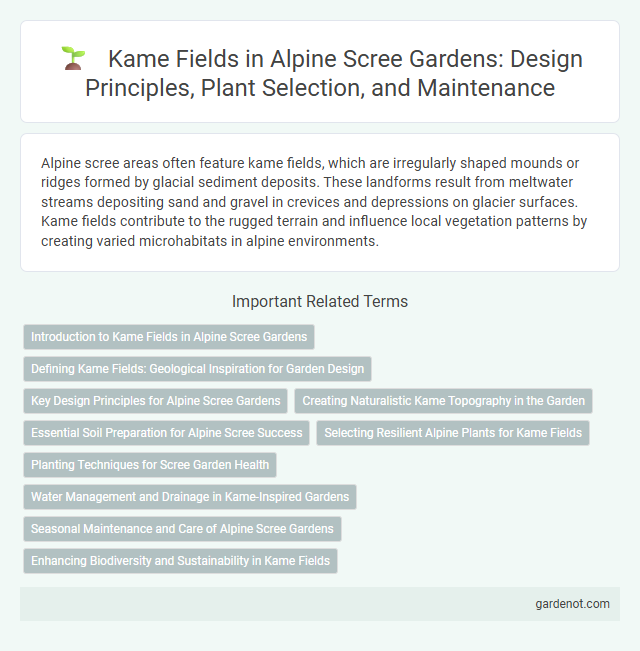Alpine scree areas often feature kame fields, which are irregularly shaped mounds or ridges formed by glacial sediment deposits. These landforms result from meltwater streams depositing sand and gravel in crevices and depressions on glacier surfaces. Kame fields contribute to the rugged terrain and influence local vegetation patterns by creating varied microhabitats in alpine environments.
Introduction to Kame Fields in Alpine Scree Gardens
Kame fields consist of irregularly shaped mounds of layered sediment deposited by meltwater in glacial environments, often found within alpine scree landscapes. These formations create unique microhabitats that support specialized flora and fauna adapted to well-drained, nutrient-poor conditions. The interplay of gravel, sand, and silt in kame fields influences water retention and soil stability, making them critical for biodiversity and geological studies in alpine regions.
Defining Kame Fields: Geological Inspiration for Garden Design
Kame fields are glacial landforms composed of irregularly shaped mounds of sand, gravel, and sediment deposited by melting glaciers, providing unique topographical features. These geological formations inspire garden design through their natural terracing and varied textures, allowing for creative landscaping that mimics authentic alpine environments. Incorporating the distinct layering and drainage patterns of kame fields enhances soil aeration and plant diversity, making them ideal models for sustainable garden architecture.
Key Design Principles for Alpine Scree Gardens
Kame fields, characterized by glacially deposited gravel and sand, inspire key design principles for alpine scree gardens by emphasizing drainage and substrate stability to mimic natural scree environments. Incorporating well-drained, coarse, angular substrates supports alpine plant root systems and prevents waterlogging, essential for species adapted to harsh, high-altitude conditions. Thoughtful layering of materials and microhabitat creation enhances biodiversity by replicating the natural microclimates and soil heterogeneity found in kame fields.
Creating Naturalistic Kame Topography in the Garden
Creating naturalistic kame topography in the garden involves replicating the irregular mounds and ridges formed by glacial sediment deposits. Utilizing varied soil layers and strategically placing gravel and sand simulates the characteristic stratified composition of kame fields. Incorporating native alpine plants stabilizes the scree while enhancing ecological authenticity and visual appeal.
Essential Soil Preparation for Alpine Scree Success
Kame fields provide unique substrates that require essential soil preparation for Alpine scree success, including thorough drainage assessment and organic matter integration to mimic natural conditions. Optimizing soil texture with coarse aggregates enhances root aeration and water retention, crucial for alpine plant establishment. Precise pH adjustment within the 5.5 to 6.5 range supports nutrient availability, promoting robust vegetation growth in scree environments.
Selecting Resilient Alpine Plants for Kame Fields
Selecting resilient alpine plants for kame fields involves prioritizing species with deep root systems and tolerance to nutrient-poor, well-drained soils typical of glacial deposits. Native grasses and cushion plants that withstand extreme temperature fluctuations and wind exposure thrive in these unstable environments. Establishing a diverse mix of hardy perennials enhances soil stabilization and promotes ecological succession on alpine scree landscapes.
Planting Techniques for Scree Garden Health
Kame fields in alpine scree feature well-draining, mineral-rich substrates essential for scree garden health. Planting techniques emphasize using native, drought-tolerant species with deep root systems to stabilize loose scree and prevent erosion. Incorporating organic mulch like decomposed granite aids moisture retention while maintaining the scree's natural aeration and thermal properties.
Water Management and Drainage in Kame-Inspired Gardens
Kame fields, formed by glacial meltwater deposits, provide natural drainage systems essential for managing water runoff in Alpine scree landscapes. In Kame-inspired gardens, strategic placement of soil mounds enhances water infiltration and reduces surface erosion, mimicking natural hydrological processes. Efficient drainage prevents waterlogging in rocky substrates, promoting plant health and sustaining biodiversity within these engineered ecosystems.
Seasonal Maintenance and Care of Alpine Scree Gardens
Seasonal maintenance of Alpine scree gardens in Kame fields involves careful removal of debris and dead plant material to promote healthy growth and prevent disease. Regular inspection ensures that drainage systems remain clear, preventing waterlogging that can damage the delicate scree environment. Applying mulch and adjusting soil pH seasonally supports the specialized alpine flora, maintaining the ecological balance of the rocky terrain.
Enhancing Biodiversity and Sustainability in Kame Fields
Kame fields, characterized by their unique sediment deposits formed by glacial meltwater, play a vital role in enhancing biodiversity by providing diverse microhabitats for specialized alpine flora and fauna. These habitats support rare plant species adapted to well-drained, nutrient-poor soils, contributing to ecological resilience and genetic diversity. Sustainable management practices, such as limiting human disturbance and promoting natural regeneration, are crucial for maintaining the ecological integrity and long-term sustainability of kame field ecosystems.
Kame field Infographic

 gardenot.com
gardenot.com